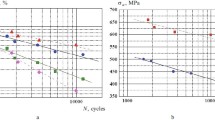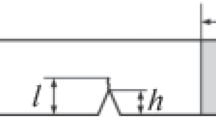Summary
Results are reported on the effects of various heat-treatment modes on the strength, plasticity, and short-time cracking resistance characteristics (KIc) for the torsion in 45KhN2MFA-Sh steel. The cyclic cracking resistances have been compared for test temperatures of 20 and 200°C for 45KhN2MFA-Sh and 50Kh3N2M2FA-Sh steels following various modes of heat treatment. The microfractographic aspects of cracking resistance in these high-tensile steels are considered.
Similar content being viewed by others
Literature cited
M. L. Bernshtein, The Strength of Steel [in Russian], Metallurgiya, Moscow (1974).
I. I. Novikov, The Theory of Metal Heat Treatment [in Russian], Metallurgiya, Moscow (1978).
O. I. Shavrin, Technology and Equipment for Machine-Component Thermomechanical Treatment [in Russian], Mashinostroenie, Moscow (1983).
M. A. Balter, Strengthening Machine Components [in Russian], Mashinostroenie, Moscow (1978).
O. N. Romaniv, The Failure Viscosity in Constructional Steels [in Russian], Metallurgiya, Moscow (1979).
O. N. Romaniv, G. N. Nikiforchin, and B. N. Andrusiv, “The crack closure effect and cyclic cracking resistance estimation for constructional steels,” Fiz.-Khim. Mekh. Mater., No. 3, 47–61 (1983).
O. N. Romaniv, A. N. Tkach, Yu. N. Lenets, and A. A. Polov, “Fatigue crack growth in constructional alloys at elevated temperatures,” ibid., No. 2, 43–50 (1986).
A. T. Stewar, The influence of environment and stress ratio on fatigue crack growth at near-threshold stress intensities in low-alloy steels,” Eng. Fract. Mech.,13, 463–478 (1980).
S. Suresh and R. O. Ritchie, “A geometric model for fatigue crack closure induced by fracture surface toughness,” Met. Irons,13A, No. 9, 1627–1631 (1982).
A. Penean, “High temperature fatigue behavior of engineering materials in relation to microstructure,” Fatigue at High Temperatures, R. P. Shelton (ed.), ASP, London and New York (1983), p. 452.
M. A. Hicks and J. E. King, “Temperature effect in fatigue thresholds and structure sensitive crack growth in a nickel-base superalloy,” In. J. Fatigue,5, No. 2, 67–74 (1983).
O. N. Romaniv, Ya. N. Gladkii, and Yu. V. Zima, “Effects of structural factors on fatigue crack kinetics in constructional alloys,” Fiz.-Khim. Mekh. Mater., No. 3, 31–36 (1977).
O. N. Romaniv, Yu. V. Zima, and G. V. Karpenko, Electron Fractography for Strengthened Steels [in Russian], Naukova Dumka, Kiev (1974).
R. F. Hanstock, Proceedings of the International Conference on Fatigue, Institute of Mechanical Engineers, London (1956).
C. E. Feltner and C. Laird, Factors Influencing the Dislocation Structures in Fatigued Metals, Preprint, Sci. Lab., Ford Motor Co., Dearborn, Michigan (1968).
B. N. Andrusiv and Yu. V. Zima, “Microfractographic Aspects of fatigue crack closure,” Fiz.-Khim. Mekh. Mater., No. 2, 112–114 (1985).
Author information
Authors and Affiliations
Additional information
Translated from Fiziko-Khimicheskaya Mekhanika Materialov, Vol. 26, No. 1, pp. 57–64, January–February, 1990.
Rights and permissions
About this article
Cite this article
Andrusiv, B.M., Zima, Y.V., Mel'nik, Y.E. et al. Effects of heat treatment mode and test temperature on the strength and cracking resistance of high-tensile low-alloy steel. Mater Sci 26, 53–59 (1990). https://doi.org/10.1007/BF00734539
Received:
Issue Date:
DOI: https://doi.org/10.1007/BF00734539




